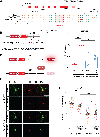RNA methylation influences TDP43 binding and disease pathogenesis in models of amyotrophic lateral sclerosis and frontotemporal dementia
- PMID: 36634675
- PMCID: PMC9899051
- DOI: 10.1016/j.molcel.2022.12.019
RNA methylation influences TDP43 binding and disease pathogenesis in models of amyotrophic lateral sclerosis and frontotemporal dementia
Abstract
RNA methylation at adenosine N6 (m6A) is one of the most common RNA modifications, impacting RNA stability, transport, and translation. Previous studies uncovered RNA destabilization in amyotrophic lateral sclerosis (ALS) models in association with accumulation of the RNA-binding protein TDP43. Here, we show that TDP43 recognizes m6A RNA and that RNA methylation is critical for both TDP43 binding and autoregulation. We also observed extensive RNA hypermethylation in ALS spinal cord, corresponding to methylated TDP43 substrates. Emphasizing the importance of m6A for TDP43 binding and function, we identified several m6A factors that enhance or suppress TDP43-mediated toxicity via single-cell CRISPR-Cas9 in primary neurons. The most promising modifier-the canonical m6A reader YTHDF2-accumulated within ALS spinal neurons, and its knockdown prolonged the survival of human neurons carrying ALS-associated mutations. Collectively, these data show that m6A modifications modulate RNA binding by TDP43 and that m6A is pivotal for TDP43-related neurodegeneration in ALS.
Keywords: ALS; RNA modifications; TDP43; m6A; methylation; neurodegeneration.
Copyright © 2022 Elsevier Inc. All rights reserved.
Conflict of interest statement
Declaration of interests The authors declare no competing interests.
Figures






References
-
- Charcot J., and Joffory A (1869). Deux cas d’atrophie musculaire progressive avec lesions de la substance grise et des faisceaux antero-lateraux de la moelle epiniere. Arcives Physiol. Neurol. Pathol. 2, 744–754.
-
- Buratti E, and Baralle FE (2008). Multiple roles of TDP-43 in gene expression, splicing regulation, and human disease. Front. Biosci. 13, 867–878. - PubMed
MeSH terms
Substances
Grants and funding
LinkOut - more resources
Full Text Sources
Other Literature Sources
Medical
Research Materials
Miscellaneous

